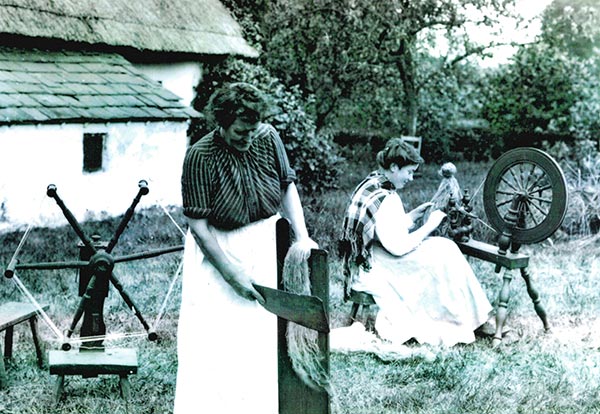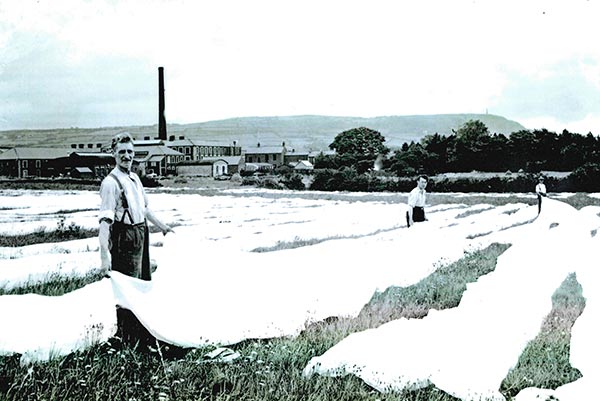
Special consideration must be given to the place of the linen industry in Aghalee Parish and throughout the Lagan Valley.
Linen was probably first introduced to the British Isles by Phoenician traders around 900 BC. Certainly, by the 11th century, flax was being cultivated in Ireland and linen used for clothing. Produced on narrow looms, this cloth was known as bandle linen.
When the French Huguenots fled to Ireland in the late 17th century, due to persecution, many settled in Lisburn and brought their skills in weaving and finishing linen. Of even greater influence were the northern English Quakers who arrived in the Lagan Valley in the 1670s and 1680s, as well as the patronage of Lord Conway and his agent George Rawdon. Ireland had built up a reputation for making fine linens.

During the 18th and early 19th centuries, linen production in Ireland was a domestic industry on the farm. Father apprenticed son and daughter and so the trade continued. Before the introduction of power looms, linen production in Ulster was a cottage industry with most spinning and weaving being done by hand. Ulster was slow to use the new looms as they could only produce coarse linens.
Most weavers rented a cottage and then spent a proportion of their time working on the landlord’s farm as part of the agreement. Weaving alone rarely brought in enough income to support a family.
It wasn’t until the Industrial Revolution in the middle of the 19th century when power looms were adapted to produce fine linens that the linen industry in Ulster was truly transformed, and the north of Ireland became one of the most important linen producers in the world. Belfast earned itself the nickname of Linenopolis.
Most of the weavers in the Aghalee area were Cambric and Muslin weavers.
Cambric is a finely woven cloth with a smooth surface appearance and can easily be dyed.
Muslin is a loosely woven cotton fabric. It’s made using the plain weave technique, which means that a single weft thread alternates over and under a single warp thread. It was used for everything from sheeting and curtains to straining the fruit for jam.

The Napoleonic wars of the early C19th created a huge demand for linen which was used for canvas, duck, and sailcloth. Linen merchants turned to women to maintain and increase production. Mechanization began to replace hand-spinning. However, spinsters (only later did the word come to mean unmarried women) could earn three times as much weaving. Still, the merchants of the Irish Linen Board had to overcome traditional gender divisions in this home-work system, and to keep up production they needed to do it fast. Many Aghalee women were involved in spinning of Lint and ‘Winning’ yarn.
The Irish Linen Board recruited female weavers, provided them with looms, and offered higher wages. They retained the right to inspect homes with the new looms, and if weavers were found to be idle or inattentive to detail the looms would be removed.
There were also incentives: cash prizes for the first 200 yards and premiums for cloth with higher thread counts.
The Lurgan/Portadown area became known throughout the world for the excellence of its fine linen and in fact held a supreme position in the production of fine handkerchief linens, generally termed 'the Cambric Trade'.
Throughout the county, a vast range of other types of linen fabrics were produced. These include Damask, sheeting, Aero linen, drying cloths or glass cloths, dress linen, suitings, ruck towelling, embroidery linen, tailors' interlining, and many cloths for industrial use.
In Aghalee, hand-loom weaving was largely a cottage industry; but there were two larger communal hand-weaving ‘factories’. One was owned by the Ussher family of ‘Hillcrest’. The other factory was at Craigmore and was owned by Messrs Shillington, a Lurgan firm. Attached to it were two hundred acres of land which were used as bleach greens.
